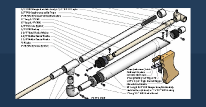(Greenlight to submit this as a contest entry, Joint effort between ACE and myself.)
The original how-to, which I expand in this write up. Most of the credit should go to ACE. I've added the video for future reference, and for the sake of the contest, there's a quick demonstration at the end of the video of ACE priming and firing the blaster.
http://www.youtube.com/watch?v=kfzt96RUhA4&feature=player_embedded
So I fell in love with ACE's SNAP design (http://www.nerfrevol....php?f=9&t=2960) and built my own. Its a great design, easy to make, and very tough. While building ACE's MK1, I Had some ideas that I could use in the next design. I shot ACE a text and got the OK to bring you the write up. I feel there's enough new ideas to call it a MK2, but I could be totally wrong on that.
In any case, here are the main aspects that make the MK2 different:
-13" body, allowing for full use of a K18.
-Double coupler to allow use of 1/2 cpvc barrels or 1/2 PVC attachments (RSCB, Hopper, Slide breech, etc".
-Homemade LS head
-No Hot glue in the piston, because on a hot day, hot glue likes to fail.
-Air tight. I managed to make my MK1 air tight without a barrel, however when I stuck a barrel in and held my thumb over the barrel, air escaped through the poly pipe coupler.
Materials:
-1 1/4" PVC (13" for body)
-1" PVC (4.5" for piston + however long you want your stock to be)
-3/4" PVC
-1" PVC tee or 90* elbow
-1/2" CPVC coupler
-1/2" PVC coupler
-3/4" PVC coupler
-5/8" Dowel rod
-11" K18 spring
-4x 1 1/4" metal washer (smallest OD you can find)
-1x 1 3/8" O-ring (I used danco #18 to get a perfect seal in mk1)
-Clothespin, nail, L Bracket for CPT
-7x #8 1/2" screws
-Etape
-Goop
-CA Glue
-(optional) Epoxy putty
-Handle of your choice (I chose to use some NF shells I had lying around for their handles, but you can use whatever you want)/
Tools:
Rotary pipe cutter
Dremel (or hacksaw if you're good enough)
Drill
Let's get started.
1. Piston
This is what will create the seal and move the air in our PT. Ace used a LS head in his version (hereby to be refereed to as MK1). We'll be making a home made one.
First take 3/4" PVC and cut out a thin ring about 1/8" thick. Yes it can be done. you need to go slow and make a pilot line first, then cut along that SLOWLY. You should get something like this:

sand it down so it's flat on both sides
Then take your 1 1/4 washer, and glue your 3/4 ring to it. Try to get it as centered as possible. then add another 1 1/4 washer on top of that. Your end result should look like this:

fill the middle with
Cut out a piece of 4.5" PVC:

And glue the Plunger head to it using CA glue or epoxy, making sure it's centered, and wrap it in Etape, and trim off the excess.

Set that aside for now, we'll come back to it later.
Note: because this is causing an unnecessary level of confusion, this IS NOT an Etape seal. You'll be putting your O-ring over the Etape. The Etape is simply there to help you adjust the seal, such as when adding Etape under an o-ring to any other plunger. The O-ring stays off for now to make your life easier, then gets added later on when the blaster is finally put together.
2. The Body.
Cut a 13" length of 1 1/4 PVC. Set that aside.
Let's make the front coupler. First take your 1/2 CPVC coupler and cut it in half. Get the bottom as flat as possible. Make sure it still has the lip inside.

Then sand it down so it can snugly fit inside your 1/2" PVC coupler. You may need to hammer it in, just remember if you cant sit your CPVC all of the way down into the coupler, you failed. You want the coupler to be tight in the PVC couple, but not so tight you cant get CPVC in or out fast enough. You'll want to goop it in.

Then sand down your 1/2 PVC coupler until it fits in your 3/4 PVC coupler. Remember that if you put too much pressure on the 1/2 PVC walls, you'll add pressure to the 1/2 CPVC coupler, making it harder to put in and take out CPVC.

Then take your Coupler and wrap some Etape around it till it fits snugly in your 1 1/4 PVC body. Then slather it in goop and slide it in. the 3/4 coupler should be flush with the 1 1/4 PVC.

Take 4 screws and put them into the coupler.
From the front of your body, measure 5" and mark it. Then measure out another 5" and mark it. You should have 5" from to the first mark, and 10" at the last mark, measured from the front. Make a line 5"8 long from one mark, and make lines to the other mark. These should be as straight as possible. This will be the channel that your bolt follows.

(disregard any numbers in the following pictures, I fucked up).
Next, mark a line 9 3/8" from the front of the body, and above the rectangle you should have, then make a 5/8" line perpendicular to the rectangle. from this mark make lines, again straight as possible, to the back of the blaster. You should have something that looks like this.

Cut out that section along those lines. You can round out the front and back of the bolt channel, so long as they don't pass the marks you've made at 5" and 10"

Your main body is done.
3. The Piston, Cont.
Take your piston and slide it in your blaster. Mark what pokes out of the bolt channel with about a 5/8" dot. make sure to leave about 1/2" MM between this and the edge of the back of the piston.
(no pic, hope you can do it without one
Then make a hole at about the center of this mark, and drill through to both sides, drilling as straight as possible. Use this as a pilot to gradually drill both holes out to a little smaller than 5/8". I managed to do this with a unibit that my brother has.

Then take your 5/8 dowel rod and slide it through both holes so that it just barely pokes out the other side. and glue it in. Then make sure to round out the side that just slightly pokes through so that it's flush with the PVC. Cut your dowel rod to about 4". Your piston now has the bolt. This is how you will prime the blaster. You can glue a washer to the back of the piston to add a bit of strength to it. My original channel wasn't long enough, so my bolt would slam against the front of it, and caused the back of the piston to break, but hopefully. your channel should be long enough where that doesn't happen.

Take out your piston and be sure to put your O-ring on the head. I use a #18 Danco O-ring. (In bold because it's such an easy step to miss. Do you really need a pic to show you how the put an O-ring on a plunger head?)

You can add or remove Etape as needed to fit in your body, but as long as you're using some sort of Sch40 1 1/4 PVC you should be able to get a good seal with some trial and error. This fixes the problem a lot of people were having with the LS head. Now you have an adjustable one. Also be sure to carve out the 1/4th of the piston opposite the bolt channel. This reduces some weight. And in case you're wondering, this piston and a traditional snap plunger head/rod weigh about the same. The Snap plunger head/rod is a tiny bit lighter. Also be sure to cut down your dowel to about three fingers length. Ideally you should be able to prime by anchoring your thumb around your handle, and using two fingers to bring the bolt back towards the handle.

Lube your body and your piston, then slide your piston into the body, them move it back so that the plunger head meets the edge of the front of the bolt guide. Ideal, if you've done this right, the back of the bolt guide should be there to stop the bolt from moving any further back.

Now depending on which side you want your bolt to be on, you'll want to make a mark either 90 degrees left or right, about 1mm from the back of the front of the bolt guide. (ignore the lower mark)

Make sure to hold your piston and your body together at the configuration in the previous step, and drill a hole through both with a bit bigger than whatever size your nail is. This will be where your nail catches on the piston.

4. The trigger
We'll be using a Clothespin trigger. I'm not actually going to explain this, as there are plenty of write ups on this subject. However I will advise that your nail be about an inch long. Be sure to round out the nail so that its pretty round. This keeps it from scraping the piston and making a channel, which will eventually ruin the catch.
Once you have your trigger glue it on. I would suggest super glue just so you can carve it off if your trigger doesn't work. I remade the trigger for my Mk1 four times, because I'm stupid.

Move your piston all the way forward.
5. The stock, Finishing the gun
Take a length of your 1" PVC, depending on how long you want your stock to be, and glue your Tee or elbow to it. Then take a shorter length of 1" PVC and put it on one end. Once done, glue a 1 1/4 washer to the longer end of your stock. This will make your life easier when you're putting the spring in.
Do 1 wrap of Etape around the long end of the stock, and put that in the end of the body, trying to keep it as parallel as possible to your trigger. Then drill three holes through body and into the stock. Your stock should only go into the body as much as the Etape is thick.

Use your screws to tap it, then unscrew it and remove the stock. With your piston all the way forward, drop the K18 in, and with the stock, push it down into the body. Either use two people or a clamp, because this is potentially dangerous. I wont be blamed if you lose a fucking eye because you aren't strong enough to compress the spring a bit, or if you aren't smart enough to use help. Be sure to line up the holes in the stock and body and put your screws back in. The first time I put this thing together my ends were facing the bolt guide. The spring ended up coming out through the guide and getting stuck, and I was very afraid that the spring would fly out and break through my new glasses, and wedge itself in my eye.
If you managed not to kill yourself in that last step, then congrats. Put a handle of your choice on the body and you are done. You should be holding something similar to this:

Even with the home made plunger head, I managed to get a perfect seal. The piston stops dead if I hold my hand over the coupler or insert a barrel and keep my finger over the barrel. However the goop seal popped, so so i scraped it out and replaced it with epoxy putty.
I've already got plans for mk3, which will have more air output, and a lighter head, along with a (hopefully) better coupler system.
Mk4 is also in the works, which will have an integrated clip breech, and may possibly be a completely new blaster, using the piston setup and possibly pump action, while keeping the same short length.
That's it. You should have a simple and sturdy blaster. I hope I made everything clear, but if you have any questions, comments, or flames, feel free to post.
Edited by andtheherois, 20 July 2011 - 05:16 PM.















